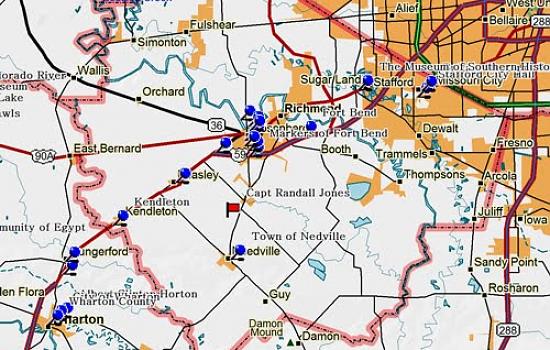Press Releases & Announcements
|
August 2014 27 |
 Officials want to link Grand Parkway with Fort Bend Parkwayomeday, somewhere in southwestern Fort Bend County, the Grand Parkway and the Fort Bend Parkway will meet - and officials have launched a study to start working out those details. The Fort Bend County Toll Road Authority has hired Brown & Gay Engineers of Houston to conduct a corridor study to assess the future connection of the two roadways. County commissioners recently signed off on the $604,000 study, paid for with toll revenues. "It's a real significant study to go do," said Mike Stone, whose consulting firm acts as the general manager of the toll road authority. "We know that we can't just go build the Fort Bend Parkway without having a logical termination point and there's no point in building the Grand Parkway without a logical termination point," Stone said. "If you just had both of them dead-ending in cow pastures, neither one of them makes sense." The Fort Bend Parkway ends at Sienna Parkway. The Grand Parkway, Texas 99, ends just north of U.S. 59. Eventually, what's called "Segment C" of the Grand Parkway would meet up with Texas 288 in Brazoria County. The project being studied, termed the "Fort Bend Grand Outer Loop," would look at constructing about seven miles of Segment C and 11 miles of the Fort Bend Parkway until they connect, Stone said. Specific areas mentioned in the study agreement include a Brazos River crossing, FM 2759 intersection, FM 762 intersection and the George Foundation property. "It is important that these major interchanges and intersections are designed for future traffic and take into account traffic flow," County Judge Bob Hebert said. The study will evaluate potential routes, taking into consideration wetlands, flood zones, hazardous materials sites, potentially historic structures, cemeteries and endangered species habitats. It will also involve identifying property owners and analyzing existing and future right of way acquisitions, traffic and revenue, drainage, costs and schedules. "Part of the study will tell us what parts of it makes sense to begin," Stone said. "You don't eat an elephant all at once." Establishing the corridor that the two toll road extensions will follow is a pressing issue, Stone said. "There may not be sufficient traffic demand for this project right now, but if you don't plan for it and buy the right-of-way there won't be a place to build it in the future," he said. "Then what happens is the next generation of young engineers and officials in Fort Bend County will have to be buying people's homes and that's not very popular." Hebert said a significant amount of right-of-way will be needed. "Much of (it) is expected to be donated. Other parcels will be negotiated based on appraisals," he said. "Imminent domain is available as a last resort, however we have been very successful on toll road projects in negotiating purchase or donation." Donations are common because landowners often want the routes to come their way, Stone said. "When we start laying out the roadway, whose property we cross makes a difference. If we can go one particular route and two-thirds of the owners will donate the land versus this one where half will, half won't, you look at it and go, 'Well we save $50 million going this way versus that way.' That's going to play a big role." The feasibility study should be complete within a year, Stone said. Preliminary engineering wouldn't be done until the next phase of the project. It's possible some parts of the Grand Outer Loop could be built in about five years, but 10 to 15 years is a more likely timeframe, he said. "What is imminent is making sure this is the right project to plan for and that we find good right-of-way and a good corridor for it to fit that doesn't prevent people from developing property but making sure that future development doesn't preclude anybody in the future from trying to construct this project. Because once you get painted in a corner, then all bets are off. "Big things take a long time," Stone said. "There's going to be years before anyone actually sees a bulldozer working on this project." For the original article, click here. |
As Seen In...
 |  |  |  |  |  | ||
 |  |  |  |  |  |
